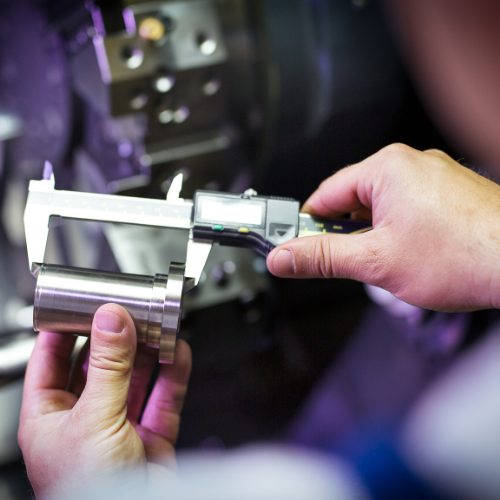1 min read
Why You Need a Manufacturing Software Tool for your People
Last time, we talked about how we often we waste our biggest resource – our people. If you find that your team is doing extra, unplanned, unnecessary...

In today’s highly competitive manufacturing landscape, production quality is crucial.
Quality issues cause scrap, rework, and recalls. A recurring problem can mean missed ship dates and a constant drain on your profit. Defects in production quality can also cause a host of other problems more difficult to measure, including customers losing confidence in your product, frustration on the operations team, or a problem with machine maintenance. They may be a sign of other, even costlier problems in production that you have yet to discover.
You cannot ignore problems in production; you must take steps to correct them. There are simple ways you can bring sustainable improvements to quality, steps that will increase overall production and provide a solid foundation for future initiatives.
Our original blog on production quality outlined tools and strategies that will give you an edge in the competitive marketplace. Since that blog, the cost of digital manufacturing solutions to manage and improve quality has reduced while automation capability has increased. Today there are even more opportunities to increase quality and reduce errors in production.
Many manufacturers see quality escapes as the cost of doing business. Production is complex, and humans are fallible, so mistakes happen. But, as technology and processes have improved, savvy companies have been able to reduce and even eliminate quality issues. Tools like MES, production control systems, production tracking and real-time data, production sign-offs, automation, and paperless manufacturing can significantly reduce quality issues.
Even implementing one or two of these tools can make a significant improvement, reducing overall cost of production and increasing production speed.
Let’s take a quick look at a few of strategies you can use to evaluate, implement, and support a production quality project.
There are many “ways” you can improve production quality, but without a guide, your efforts may not see the results you need. Consider the needs of your customer, and the requirements they have for an order, to identify the highest priority quality steps. Analyze your production cycle as a customer advocate. The results of this exercise will help you define your quality requirements so you can focus your efforts where they will have the biggest impact.
Human errors and mistakes will happen in manufacturing, and wherever you can automate paperwork or processes, you improve quality. With a digital toolset and automation, you can eliminate many of the causes of human errors in production. For example, barcodes and a digital picklist will ensure your team is using the right parts, tools, and materials. With automation in place, workers can focus on what they do best, quality production, and let the system handle the rest.
A simple user sign-off, especially in a digital production system, ensures work was completed correctly and nothing was missed. It provides a second set of eyes and controls overproduction, which is especially important as manufacturing has gotten more complex and order customization is common. In addition, process enforcement and work sign-offs are one way you can correct actions that frequently result in quality escapes.
Accurate and timely data is critical to identifying problems early and adjusting processes to improve quality. Don’t rely on your team filling out reports after work is complete. That data is a snapshot of the past and isn’t actionable. Automate data collection to select and collect the data you need, and to ensure you have the most accurate data available. With dashboards and real-time reports, you can make better decisions regarding production quality.
Fixing a problem at one step in production is good, but it may not address the root cause of your quality issues. The point at which an issue occurred may not be where the problem started. To make your quality initiative sustainable, quality needs to be addressed at every point in production. Monitor and collect data from the entire production cycle. Collect and keep historical records. Involve management, machine maintenance teams, engineers, and even customer service in the quality initiative. Track progress and reward results in meeting your quality goals.
In production, paper causes problems. A smudge on work instructions can result in a mistake. Paper is static, and an engineering change may never reach the shop floor. Paper records can be lost. Inputting data from a paper document can leave you with incorrect information. There are countless ways that paper can contribute to the quality escapes that you and your customers are paying for. Wherever possible, remove paper from your processes.
Many problems happen when your production team is forced to become researchers or private investigators because they can’t find the information they need to do their job. Incorporate all production documents and data in common records that can be accessed when and where they are needed. Eliminate the struggle production has in finding information when they need it by linking relevant data to each operation.
You may not think it is the right time to start a quality improvement project, but this is a huge mistake. The fact is, many companies know they have a problem with quality, but continue to do nothing. They wait, delay, and create excuses. Meanwhile, they’re bleeding money in scrap, waste, late shipments, lost customers, and worse.
Any quality project should start by determining your ROI for a quality improvement. Take a moment to calculate the Cost of Quality (COQ) in order to discover, evaluate, and mitigate any gaps in cost. From that, you can determine your ROI and benefit from your activities related to quality improvement.
Automatically collect data and ensure specifications are met. Shorten the time it takes to identify and correct a defect with automatic tolerances and a closed-loop disposition system. Create proactive alerts for inventory shortage, machine issues, or bottlenecks. Every one of these steps will reward you with quality improvement. With Quantum, you have the tools in place to make this happen.
Companies that have embraced digital manufacturing tools like Quantum have seen their production quality increase, often dramatically, by using readily available technology to aid, manage and control the materials and process workflow steps. Automating the process of collecting metrics and responding to defects at the point of occurrence isn’t difficult, and will improve quality and profitability.
Contact CIMx Software to see how paperless manufacturing can improve quality for you.

1 min read
Last time, we talked about how we often we waste our biggest resource – our people. If you find that your team is doing extra, unplanned, unnecessary...

In our previous blog, we talked about your people; this is a resource that is finite, moving, and expensive. You must avoid extra, unplanned,...

1 min read
It’s hard to believe that we’re already at the end of the first quarter of 2022. How are you doing on goals? What changes have you made to drive...